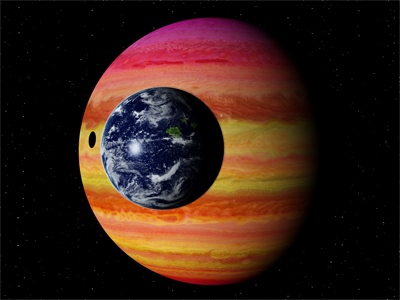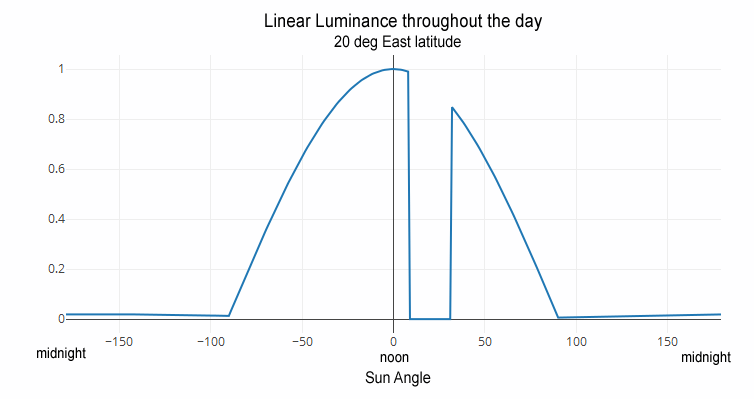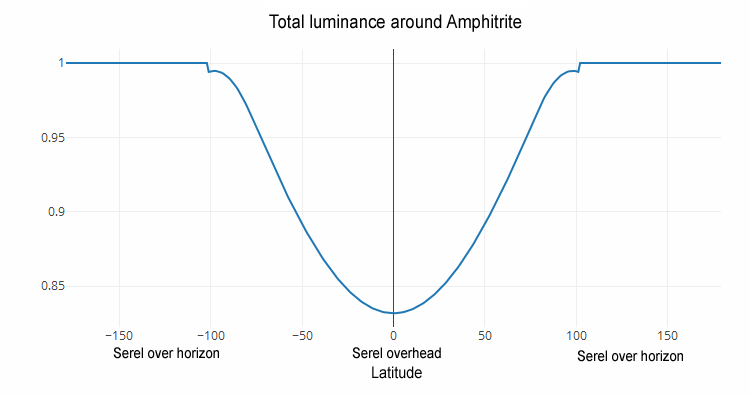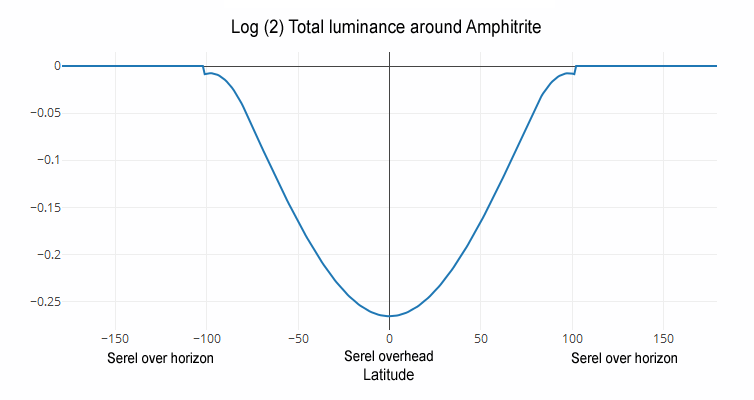 300k
300k
Arella's planet is fictitious, but her star isn't. Her world circles HD 172051 (also called HIP 91438) about 43 light years from here.
| Mass | 1.72×1030 kg (0.865 Sol) |
|---|---|
| Mean radius | 626753 km (0.90 Sol) |
| Temperature | 5638K |
| Life span | 1.62x1010 years |
| Age | 4.3x109 years |
| Spectral type | G5V |
| Apparent mag | 5.85 |
| Metallicity [Fe/H] | –0.21 dex |
| Constellation | Sagittarius |
| Right ascension | 18h 38m 53.4005s |
| Declination | -21o 03' 06.7368" |
| Local Brightness | 121291 lux (0.95 Sol) |
Arella lives on a large moon called Amphitrite. It orbits a gas giant called Serel. Amphitrite is just large enough to hold an atmosphere and has a gravity around 2/3 of Earth's. It orbits close enough to Serel to be tidally locked, so Arella always sees Serel looming large in her sky.
Amphitrite
| Mean radius | 4332 km (0.68 Earth) |
|---|---|
| Surface area | 2.358×108 km2 (0.462 Earth) |
| Volume | 3.405×1011 km3 (0.314 Earth) |
| Mass | 1.737×1024 kg (0.29 Earth) |
| Mean density | 5.1 g/cm3 |
| Surface gravity | 6.176 m/s2 (0.63 g) |
| Day Length | 33.6 Earth hours |
| Orbit radius | 478720 km |
| Orbital period | 33.6 Earth hours |
| Escape velocity | 7.315 km/s |
| Albedo | 0.26 |
| Atmos. Press | 0.93 earth |
| Land % | 0.2% |
| Max elevation | 97m |
| Obliquity | 0.11 deg |
Serel
| Mean radius | 94380 km (1.35 Jupiter) |
|---|---|
| Surface area | 1.12×1011 km2 (1.82 Jupiter) |
| Volume | 3.52×1015 km3 (2.45 Jupiter) |
| Mass | 4.437×1027 kg (2.34 Jupiter) |
| Mean density | 1.26 g/cm3 |
| Surface gravity | 33.245 m/s2 (3.39 g) |
| Day Length | 11.63 earth hours |
| Orbit radius | 1.30152x108 km (0.87au) |
| Orbital period | 318.7 Earth days, 227.6 Amphitrite days |
| Escape velocity | 79.217 km/s |
| Albedo | 0.49 |
| Angle in sky | 22.3 deg (44.6 Earth Moon widths) |
Eclipses
Amphitrite is tidally locked so Serel stays put in the sky. The side of Amphitrite that faces Serel experiences a daily 2.08 hr eclipse. The following two plots show a typical eclipse, here at 20deg longitude. The second is a log plot that show a typical visual response to light levels. As Serel's phase approaches full at night, light levels increase. A full Serel casts over 2000 lux on Amphitrite's surface.


The side of facing Serel recieves less total illumination as shown in the following two plots.


History
Amphitrite started out with 12% land cover. Land species evolved. Plate tectonics ended. Later, hominid species evolved. Land erosion reduced land coverage and continents sank below the sea. Some land species, including the hominids, successfully made the transition back to water before their land completely disappeared beneath the sea.
Copyright © 2017-2018 by David White
This page last updated 24-Jan-2018